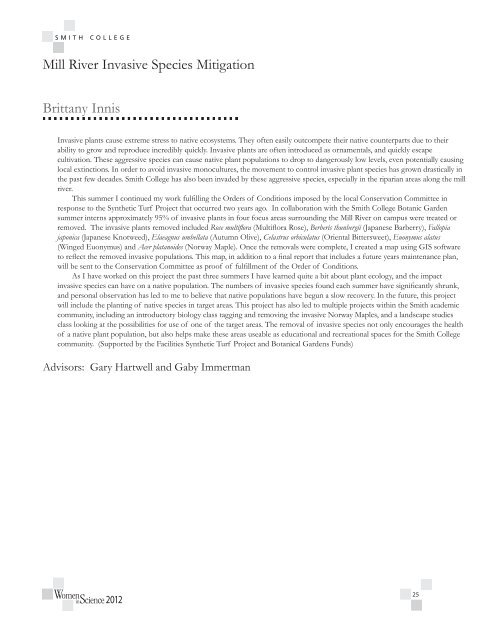Brugia Malayi - Clark Science Center - Smith College
Brugia Malayi - Clark Science Center - Smith College
Brugia Malayi - Clark Science Center - Smith College
Create successful ePaper yourself
Turn your PDF publications into a flip-book with our unique Google optimized e-Paper software.
Mill River Invasive Species Mitigation<br />
Brittany Innis<br />
Invasive plants cause extreme stress to native ecosystems. They often easily outcompete their native counterparts due to their<br />
ability to grow and reproduce incredibly quickly. Invasive plants are often introduced as ornamentals, and quickly escape<br />
cultivation. These aggressive species can cause native plant populations to drop to dangerously low levels, even potentially causing<br />
local extinctions. In order to avoid invasive monocultures, the movement to control invasive plant species has grown drastically in<br />
the past few decades. <strong>Smith</strong> <strong>College</strong> has also been invaded by these aggressive species, especially in the riparian areas along the mill<br />
river.<br />
This summer I continued my work fulfilling the Orders of Conditions imposed by the local Conservation Committee in<br />
response to the Synthetic Turf Project that occurred two years ago. In collaboration with the <strong>Smith</strong> <strong>College</strong> Botanic Garden<br />
summer interns approximately 95% of invasive plants in four focus areas surrounding the Mill River on campus were treated or<br />
removed. The invasive plants removed included Rose multiflora (Multiflora Rose), Berberis thunbergii (Japanese Barberry), Fallopia<br />
japonica (Japanese Knotweed), Elaeagnus umbellata (Autumn Olive), Celastrus orbiculatus (Oriental Bittersweet), Euonymus alatus<br />
(Winged Euonymus) and Acer platanoides (Norway Maple). Once the removals were complete, I created a map using GIS software<br />
to reflect the removed invasive populations. This map, in addition to a final report that includes a future years maintenance plan,<br />
will be sent to the Conservation Committee as proof of fulfillment of the Order of Conditions.<br />
As I have worked on this project the past three summers I have learned quite a bit about plant ecology, and the impact<br />
invasive species can have on a native population. The numbers of invasive species found each summer have significantly shrunk,<br />
and personal observation has led to me to believe that native populations have begun a slow recovery. In the future, this project<br />
will include the planting of native species in target areas. This project has also led to multiple projects within the <strong>Smith</strong> academic<br />
community, including an introductory biology class tagging and removing the invasive Norway Maples, and a landscape studies<br />
class looking at the possibilities for use of one of the target areas. The removal of invasive species not only encourages the health<br />
of a native plant population, but also helps make these areas useable as educational and recreational spaces for the <strong>Smith</strong> <strong>College</strong><br />
community. (Supported by the Facilities Synthetic Turf Project and Botanical Gardens Funds)<br />
Advisors: Gary Hartwell and Gaby Immerman<br />
2012<br />
25

















